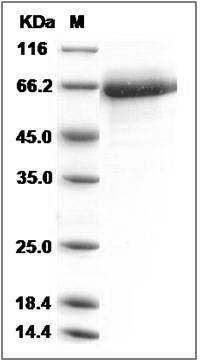-
Product Name
Cynomolgus CD84 (Fc Tag) recombinant protein
- Documents
-
Description
The CD2 family receptors are type I transmembrane glycoproteins belonging to immunoglobulin (Ig) superfamily characterized by a membrane-proximal Ig constant 2 (C2) domain and a membrane-distal variable (V) domain that is responsible for ligand recognition. CD84, also known as LY9B and SLAMF5, is a homophilic member of the SLAM (signaling lymphocyte activation molecule) subfamily of the CD2 family. The SLAM family receptorsmediate signal transduction through the interaction of its ITSM (immunoreceptor tyrosine-based switch motifs) in the intracellular region and the SH2 domain of adaptor molecules SAP (SLAM-associated protein) and EAT-2 (EWS-activated transcript 2), and accordingly modulate both adaptive and innate immune responses. The CD84-CD84 interaction was independent of its cytoplasmic tail. Thus, CD84 is its own ligand and acts as a costimulatory molecule. CD84 is expressed on cells from almost all hematopoietic lineages and on CD34+ hematopoietic progenitor cells, suggesting that CD84 serves as a marker for committed hematopoietic progenitor cells.
-
Protein name
Uncharacterized protein
-
Protein short names
DKFZP781E2378; LY9B; SLAMF5; MCD84; HCD84; CD84; CDW84; A130013D22RIK
-
Uniprot ID
F6QA53
-
Gene Name
CD84
-
Source/Expression Host
Human Cells
-
Expression Plasmid/cDNA
A DNA sequence encoding the cynomolgus CD84 (F6QA53) (Met1-Arg220) was expressed with the Fc region of human IgG1 at the C-terminus.
-
Protein Species
Cynomolgus
-
Molecular weight
The recombinant cynomolgus CD84 is a disulfide-linked homodimer. The reduced monomer comprises 440 amino acids and has a calculated molecular mass of 49.2 KDa. The apparent molecular mass of the protein is approximately 57 and 65 KDa respectively in SDS-PAGE.
-
Purity
> 95 % as determined by SDS-PAGE
-
Validations

Cynomolgus CD84 Protein (Fc Tag) SDS-PAGE
Related Products / Services
Please note: All products are "FOR RESEARCH USE ONLY AND ARE NOT INTENDED FOR DIAGNOSTIC OR THERAPEUTIC USE"
